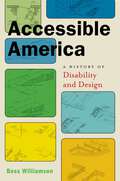Title search results
Showing 1 - 4 of 4 items

Accessible America: a history of disability and design (Crip #2)
By Bess Williamson. 2019
Braille (Contracted), Electronic braille (Contracted), DAISY audio (CD), DAISY audio (Direct to player), DAISY audio (Zip)
Disabilities, Arts and entertainment, History, Social issues
Human-narrated audio, Human-transcribed braille
A history of design in the United States that provides increased accessibility for those with physical, sensory, and cognitive disabilities.…
Also discusses the individuals and events that propelled the civil rights movement leading to the Architectural Barriers Act and the Americans with Disabilities Act. 2019
Crippled: Austerity And The Demonization Of Disabled People
By Frances Ryan. 2019
Braille (Contracted), Electronic braille (Contracted), DAISY Audio (CD), DAISY Audio (Direct to Player), DAISY Audio (Zip), DAISY text (Direct to player), DAISY text (Zip), Word (Zip), ePub (Zip)
Politics and government
Synthetic audio, Automated braille
The austerity crisis and threat to disability rightsIn austerity Britain, disabled people have become the favourite target. From social care…
to the benefits system, politicians and media alike have made the case Britain’s 12 million disabled people are a drain on the public purse. In Crippled, leading commentator Frances Ryan exposes the disturbing reality, telling the story of those most affected by this devastating regime. This includes a paralyzed man forced to crawl down the stairs because the council wouldn’t provide accessible housing; the malnourished woman sleeping in her wheelchair; and the young girl with bipolar forced to turn to sex work to survive. Through these personal stories, Ryan charts how in recent years the public attitude towards disabled people has transformed from compassion to contempt: from society’s “most vulnerable” to benefit cheats. Crippled is a damning indictment of a safety net gone wrong, and a passionate demand for an end to austerity measures hitting those most in need.
Being Heumann: An Unrepentant Memoir of a Disability Rights Activist
By Judith Heumann, Kristen Joiner. 2019
Braille (Contracted), Electronic braille (Contracted), DAISY Audio (CD), DAISY Audio (Direct to Player), DAISY Audio (Zip), DAISY text (Direct to player), DAISY text (Zip), Word (Zip), ePub (Zip)
Biography of persons with disabilities, History, Disabilities
Synthetic audio, Automated braille
One of the most influential disability rights activists in US history tells her personal story of fighting for the right…
to receive an education, have a job, and just be human. A story of fighting to belong in a world that wasn't built for all of us and of one woman's activism--from the streets of Brooklyn and San Francisco to inside the halls of Washington--Being Heumann recounts Judy Heumann's lifelong battle to achieve respect, acceptance, and inclusion in society. Paralyzed from polio at eighteen months, Judy's struggle for equality began early in life. From fighting to attend grade school after being described as a "fire hazard" to later winning a lawsuit against the New York City school system for denying her a teacher's license because of her paralysis, Judy's actions set a precedent that fundamentally improved rights for disabled people. As a young woman, Judy rolled her wheelchair through the doors of the US Department of Health, Education, and Welfare in San Francisco as a leader of the Section 504 Sit-In, the longest takeover of a governmental building in US history. Working with a community of over 150 disabled activists and allies, Judy successfully pressured the Carter administration to implement protections for disabled peoples' rights, sparking a national movement and leading to the creation of the Americans with Disabilities Act. Candid, intimate, and irreverent, Judy Heumann's memoir about resistance to exclusion invites readers to imagine and make real a world in which we all belong.
Accessible America: A History of Disability and Design (Crip #2)
By Null Bess Williamson. 2019
Braille (Contracted), Electronic braille (Contracted), DAISY Audio (CD), DAISY Audio (Direct to Player), DAISY Audio (Zip), DAISY text (Direct to player), DAISY text (Zip), Word (Zip), ePub (Zip)
Arts and entertainment, History
Synthetic audio, Automated braille
A history of design that is often overlooked—until we need itHave you ever hit the big blue button to activate…
automatic doors? Have you ever used an ergonomic kitchen tool? Have you ever used curb cuts to roll a stroller across an intersection? If you have, then you’ve benefited from accessible design—design for people with physical, sensory, and cognitive disabilities. These ubiquitous touchstones of modern life were once anything but. Disability advocates fought tirelessly to ensure that the needs of people with disabilities became a standard part of public design thinking. That fight took many forms worldwide, but in the United States it became a civil rights issue; activists used design to make an argument about the place of people with disabilities in public life.In the aftermath of World War II, with injured veterans returning home and the polio epidemic reaching the Oval Office, the needs of people with disabilities came forcibly into the public eye as they never had before. The US became the first country to enact federal accessibility laws, beginning with the Architectural Barriers Act in 1968 and continuing through the landmark Americans with Disabilities Act in 1990, bringing about a wholesale rethinking of our built environment. This progression wasn’t straightforward or easy. Early legislation and design efforts were often haphazard or poorly implemented, with decidedly mixed results. Political resistance to accommodating the needs of people with disabilities was strong; so, too, was resistance among architectural and industrial designers, for whom accessible design wasn’t “real” design.Bess Williamson provides an extraordinary look at everyday design, marrying accessibility with aesthetic, to provide an insight into a world in which we are all active participants, but often passive onlookers. Richly detailed, with stories of politics and innovation, Williamson’s Accessible America takes us through this important history, showing how American ideas of individualism and rights came to shape the material world, often with unexpected consequences.